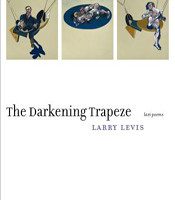The Darkening Trapeze by Larry Levis exemplifies his wide, sweeping lyrical style we have come to adore and recognize. Published posthumously and edited by David St. John, The Darkening Trapeze reads as an echo of what Levis was and still is. As beautifully stated in “A Singing in the Rocks”: “He was the singing & the no one there.” Such is this collection: resonant in its beauty and resounding voice of a voice, from this point forward, lost. The collection is expansive: geographically stretching from Missouri to Florida to points far across the ocean; chronologically, it reaches backward in time to the New World, van Gogh, and Wallace Stevens having his nails filed. The speakers and subjects who appear throughout The Darkening Trapeze are men and women we’ve seen walk the streets. They are like us: struggling, nostalgic, wandering, and at times, lost. In “Elegy With a Darkening Trapeze Inside It,” Levis, in his practiced and patient way, turns the reader’s attention, for a moment, to the following memory:
I worked with men in vineyards once who were paid
In wages thin as water, cash that evaporated & rose like heat.
They lived in rows of makeshift sheds the owners hauled
Into an orchard too old to bother picking anymore,
And where, at dusk, a visible rushing hunger
Raced along the limbs of the trees surrounding them.
His speaker resides here for a portion of the poem as though finding a small place in his memory to rest only to re-circle like a dog, or a rider pulling tight on the inner rein of a horse, and round in on the meaning: “Every revolution ends, or it begins, in memory.” Memory and the fluctuation of time are present from the first poem of the collection. “Gossip In the Village” oscillates, as many of Levis’s poems, between the present moment of the poem and the memory—or multiple memories. These memories occur to the speaker as he moves through the present, ever reminded and pulled backward to something he must, for a moment, relive. “Gossip In the Village,” moves in this way:
The village slept in the gunmetal of its evening.
And there, through a thin dress once, I touched
A body so alive & eager I thought it must be
Someone else’s soul…
 The speakers in The Darkening Trapeze consistently recognize a change, many times noting a difference they feel around them. But in “New Year’s Eve at the Santa Fe Hotel, Fresno, California,” the speaker recognizes suddenly that the change is none other than a change within the self. The poem begins with the speaker remembering “Smoke, laughter, & a bar whose solemn oak / Has outlasted worse times than [his] own…” The scene is set with dancing, and “whole families / Of Basques,” until the speaker claims:
The speakers in The Darkening Trapeze consistently recognize a change, many times noting a difference they feel around them. But in “New Year’s Eve at the Santa Fe Hotel, Fresno, California,” the speaker recognizes suddenly that the change is none other than a change within the self. The poem begins with the speaker remembering “Smoke, laughter, & a bar whose solemn oak / Has outlasted worse times than [his] own…” The scene is set with dancing, and “whole families / Of Basques,” until the speaker claims:
Once a year
I come back to this place, embrace friends,
And drink to what got lost in bad translation:
The town we tried to change, changed anyway.
The street we blocked off on a warm day
In 1970 is lined with cute
Boutiques, & that girl, once queen…
The poem continues, slipping further into the past, the speaker remembering not only the place, but the people he used to drink with when he was young and reveling; it is Levis at his most concrete, walking the reader through a specific place and allowing the memory to remain there rather than turn a corner. Until finally, in the last two-thirds of the poem, the speaker transitions the reader back into the present with honesty:
I thought
That coming back here always showed me just
How much this place has changed; but no. The only
Real change is me. Now, when I sit
Across from two friends at a table, I am
Whatever’s distant, snow beginning to fall
On the plains; a thief’s fire. Someday I won’t
Be home to anyone.
Reading The Darkening Trapeze as the last poems written by Levis, one cannot ignore the paramount themes—themes that have found home in much of Levis’s poetry—elegy, loss, the self, and age. Can we change what has already been, Levis seems to continually question. And in turn his readers, after reading this collection, might question: if not, then why walk the past so frequently, so persistently? If one continually revisits the past, does it mean it is not lost? These are questions that arise when reading The Darkening Trapeze. A strong collection divided into five sections, these posthumous poems allow a reader to continue to experience Levis’s lyrical work. In this way, The Darkening Trapeze is truly a gift. In it, Levis invites us to walk backward with him to a time when “van Gogh had already cut off his ear…He did it because of the pain of Ménière’s” or to a time, a realization that “it was all sweet, yes, & stupid, / Like life itself, or the end of Candide” (“The Worm In the Ear,” “Anonymous Source”). The reader will walk easily through The Darkening Trapeze because she is welcome. The poems are staggering in their beauty, wisdom, and captivation. There is a heartbreaking and promising simultaneity to Levis’s poetry—and one feels it, too, in this last collection—represented in the final lines of “Elegy With a Darkening Trapeze Inside It”: “How it is too late to change things now. How it isn’t.”




